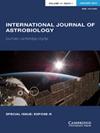Planetary geodynamics and age constraints on circumstellar habitable zones around main sequence stars
IF 1
4区 物理与天体物理
Q3 ASTRONOMY & ASTROPHYSICS
引用次数: 0
Abstract
Planetary geodynamics may have an important influence over planetary habitability and the boundaries of the circumstellar habitable zone (CHZ) in space and time. To investigate this we use a minimal parameterized model of the co-evolution of the geosphere and atmosphere of Earth-like planets around F, G, K and M main sequence stars. We found the CHZ for the present Solar System located between 0.92 and 1.09 au for a 1.0 M $_{\oplus }$ Earth-like planet, extendible to 1.36 au for a 4.0 M $_{\oplus }$ planet. In the literature, the CHZ varies considerably in width and border location, but the outer edges tend to be more spread out than the inner edges, showing a higher difficulty in determining the outer edge. Planetary mass has a considerable effect on planetary geodynamics, with low-mass planets cooling down faster and being less capable of maintaining a rich carbon dioxide atmosphere for several billions of years. Age plays a particularly important role in the width of the CHZ as the CHZ contracts in both directions: from the inner edge (as stellar luminosity increases with time), and from the outer edge (as planetary heat flux and seafloor spreading rate decrease with time). This strongly affects long-lived habitability as the 5 Gyr continuous CHZ may be very narrow or even non-existent for low-mass planets (<0.5 M $_{\oplus }$ ) and fast-evolving high-mass stars (>1.1 M $_{\odot }$ ). Because of this, the mean age of habitable terrestrial planets in our Galaxy today may be younger than Earth's age. Our results suggest that the best targets for future surveys of biosphere signatures may be planets between 0.5 and 4.0 M $_{\oplus }$ , in systems younger than the Solar System. These planets may present the widest and long-lived CHZ.主序星周围星周宜居带的行星地球动力学和年龄约束
行星地球动力学可能对行星的可居住性和星周可居住带的时空边界产生重要影响。为了研究这一点,我们使用了F、G、K和M主序星周围类地行星地圈和大气共同演化的最小参数化模型。我们发现,对于1.0 M $_{\oplus }$类地行星,当前太阳系的CHZ介于0.92和1.09 au之间,对于4.0 M $_{\oplus }$类地行星,CHZ可扩展到1.36 au。在文献中,CHZ的宽度和边界位置变化很大,但外缘往往比内缘更分散,表明确定外缘的难度更高。行星质量对行星地球动力学有相当大的影响,低质量的行星冷却得更快,在几十亿年的时间里维持富含二氧化碳的大气层的能力也更弱。年龄对CHZ的宽度起着特别重要的作用,因为CHZ从两个方向收缩:从内缘(随着恒星光度随时间增加)和从外缘(随着行星热通量和海底扩散率随时间减少)。这强烈影响了长期的可居住性,因为对于低质量行星(1.1 M $_{\odot }$), 5 Gyr连续CHZ可能非常狭窄甚至不存在。正因为如此,我们银河系中适宜居住的类地行星的平均年龄可能比地球的年龄要小。我们的结果表明,未来生物圈特征调查的最佳目标可能是0.5到4.0 M $_{\oplus }$之间的行星,在比太阳系年轻的系统中。这些行星可能呈现出最宽、寿命最长的CHZ。
本文章由计算机程序翻译,如有差异,请以英文原文为准。
求助全文
约1分钟内获得全文
求助全文
来源期刊

International Journal of Astrobiology
地学天文-地球科学综合
CiteScore
3.70
自引率
11.80%
发文量
45
审稿时长
>12 weeks
期刊介绍:
International Journal of Astrobiology is the peer-reviewed forum for practitioners in this exciting interdisciplinary field. Coverage includes cosmic prebiotic chemistry, planetary evolution, the search for planetary systems and habitable zones, extremophile biology and experimental simulation of extraterrestrial environments, Mars as an abode of life, life detection in our solar system and beyond, the search for extraterrestrial intelligence, the history of the science of astrobiology, as well as societal and educational aspects of astrobiology. Occasionally an issue of the journal is devoted to the keynote plenary research papers from an international meeting. A notable feature of the journal is the global distribution of its authors.
 求助内容:
求助内容: 应助结果提醒方式:
应助结果提醒方式:


